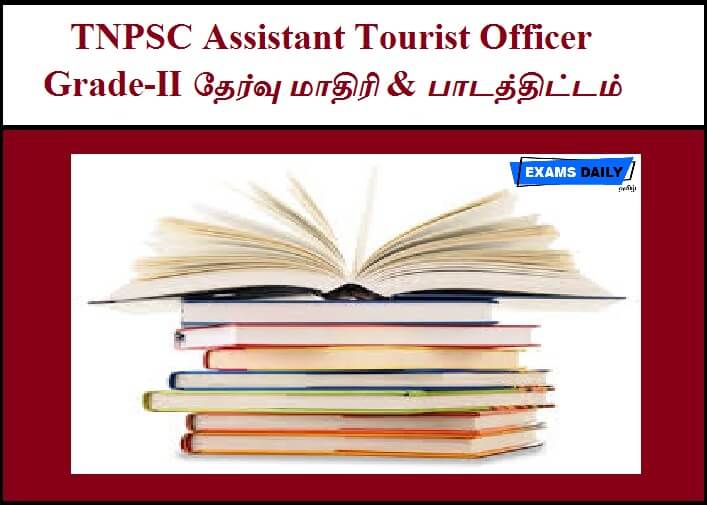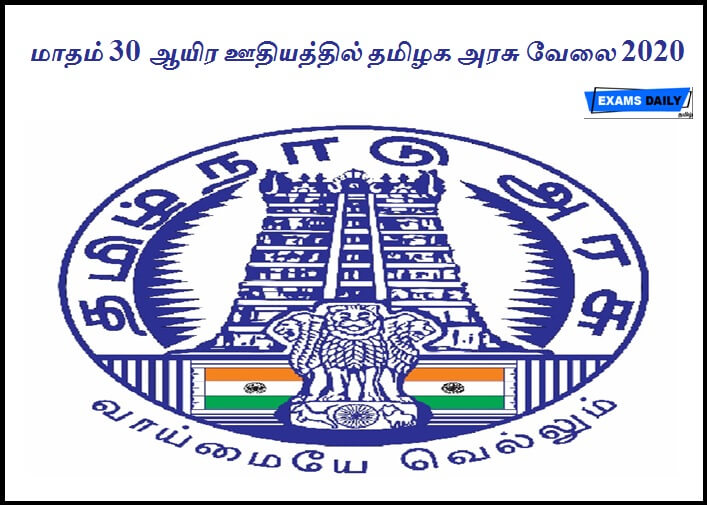TNPSC Assistant Tourist Officer, Grade-II தேர்வு மாதிரி & பாடத்திட்டம்
தமிழ்நாடு அரசு பொதுப்பணியாளர் தேர்வாணையம் (TNPSC) ஆனது உதவி சுற்றுலா அதிகாரி தேர்விற்கான அதிகாரப்பூர்வ அறிவிப்பை வெளியிட்டுள்ளது. தகுதியான விண்ணப்பதாரர்கள் 22.07.2019 முதல் 20.08.2019 வரை விண்ணப்பிக்கலாம். TNPSC உதவி சுற்றுலா அதிகாரி தேர்வு 29.09.2019 அன்று நடைபெறும்.
தமிழ்நாடு அரசு பொதுப்பணியாளர் தேர்வாணையம் அதிகாரப்பூர்வ அறிவிப்பு 2019
TNPSC Assistant Tourist Officer Grade-II Syllabus & Exam Pattern Video Click Here
Video Click Here
இங்கு கொடுக்கப்பட்டுள்ள அனைத்து தொகுதிகளும் முக்கியமான பொது அறிவு குறிப்புகளாகும். இது போட்டி தேர்வுக்கு மிகவும் பயன்படும். போட்டி தேர்வாளர்கள் கீழ்கண்ட தொகுதிகளை படித்து பயன்பெற வாழ்த்துகிறோம்.
தேர்வு மாதிரி :
| Subject | Duration of Examination | Maximum of Marks | Minimum Qualifying Marks of Selection |
| Paper–I
Travel and Tourism (Degree Standard) (Total = 200 questions) |
3 Hours | 300 | 150 |
| Paper–II
General Studies (Degree Std.) (75 questions) + Aptitude and Mental Ability Test (S.S.L.C Std) (25 questions) (Total = 100 questions) |
2 Hours | 200 | |
| Total | 500 |
ATO தேர்வின் Paper I பாடத்திட்டம் :
Unit – I: PRINCIPLES AND PRACTICES OF TOURISM:
Introduction to tourism- Meaning and Scope, Concept ,Components, and types of Tourism – Emerging trends- Evolution of Tourism in India- Ministry of TourismGovernment of India – Department of Tourism – Government of Tamil Nadu.
UNIT- II: TOURISM PRODUCTS OF INDIA
Unique features of Tourism Products- Tourist attraction Hills/ Beaches/ Mountains/ WaterBodies- Forts/ Palaces/ Fairs and festivals/Folk dances/Dance /Music/-Art and craftsTemples/Churches/ Mosque and other religious worship places- UNESCO World Heritage sites- Flora and Fauna- Major wildlife sanctuaries and National parks- Major Tourist Circuits of India- Land, Air and Water based adventure activities, Guidelines and Regulations -Ancient Monuments Preservation Act 1904- Ancient Monuments and Archaeological Site and Remains Act 1958.
UNIT – III: TRANSPORT
History- Land-Water and Air- Air Industry / Airlines in India/ Functions/ Present policies-Air
Charters- Growth of Road Transport – Indian Road Network – Major rail network of Indiatypes of Rail Tours in India- Water Transport- History and Development-Historical PastCruise ships-Ferries- Hovercraft- River and Canal boats- Boat Houses.
UNIT- IV: ACCOMMODATION OPERATIONS
Origin and growth of hotels- Classification of Hotels on the basis of Size, Location,
Facilities, Plan , Service and Ownership- Allied Catering services- Supplementary
Accommodation- House Keeping- Front Office Management- Booking procedures- Types
of Food and Beverages.
UNIT-V: TOURISM MARKETING
Unique features of Tourism Marketing – Market Segmentation- Marketing mix- tourists
behavior- Distribution channel and its characteristics- Market research- Market forecastMarketing Promotions- Tools of Promotion- E-Marketing- Domestic and International
Travel Marts- Branding of Tourism products- “Incredible India” Campaign- “Enchanting
Tamil Nadu: Experience yourselves”- Swachh Bharat Abhiyan- Destination Life Cycle.
UNIT-VI: TOURISM POLICY AND PLANNING
Need and Objectives of Tourism Policy-John Sargeant Committee- L.K.Jha Committee
(Ad-hoc Committee) – 1963, National Tourism Policy -1982, Yunus committee 1988-
Tourism Finance Corporation of India, National Action Plan on Tourism – 1992- National
Tourism Policy-2002 – Tourism in Five year plans- Tourism policies of Tamil Nadu.
UNIT-VII: FUNCTIONS OF TRAVEL AGENCY AND TOUR OPERATION
Tour Operation Procedures – Tour Package – Itinerary preparation- Tour Costing- Travel
formalities – Passport/ VISA /Health Regulations/ Travel insurance/ Customs Clearance/
Foreign Exchange formalities – Baggage rules.
UNIT- VIII: TOURISM GEOGRAPHY
Physical Geography of India- Climate- Sub continent-River system-Mountains- Plains –
Political Geography of India- World Time zone, GMT- India Time Zone.
UNIT-IX: TOURISM ORGANIZATIONS
Organisation and Functions of WTO, ICAO, IATA, PATA, TAAI, IH &RA, SIHRA, FHRAI,
NTO.
UNIT-X: IMPACT OF TOURISM
Positive and negative- Socio-Cultural and Economic Impact – Physical / Environmental
Impact: Earth Summits.
ATO தேர்வின் Paper II பாடத்திட்டம் :
UNIT– I: GENERAL SCIENCE
Physics: Universe – General scientific laws – Scientific instruments – Inventions and
discoveries – National scientific laboratories – Science glossary – Mechanics and properties
of matter – Physical quantities, standards and units – Electricity and magnetism –
Electronics and communication – Heat, light and sound – Atomic and nuclear physics –
Solid State Physics – Spectroscopy – Geophysics – Astronomy and space science.
Chemistry: Elements and Compounds – Acids, bases and salts – Oxidation and reduction
– Chemistry of ores and metals – Carbon, nitrogen and their compounds – Fertilizers,
pesticides, insecticides – Biochemistry and biotechnology – Electrochemistry – Polymers
and plastics.
Botany: Main Concepts of life science – The cell-basic unit of life – Classification of living
organism – Nutrition and dietetics – Respiration – Excretion of metabolic waste –
Bio-communication.
Zoology: Blood and blood circulation – Endocrine system – Reproductive system –
Genetics the science of heredity – Environment, ecology, health and hygiene,
Bio-diversity and its conservation – Human diseases, Prevention and remedies –
Communicable diseases and non-communicable diseases – Alcoholism and drug abuse –
Animals, plants and human life.
UNIT-II: CURRENT EVENTS
இந்தியாவின் வரலாறு
- வரலாற்றுக்கு முற்பட்ட காலம்
- சிந்து சமவெளி நாகரிகம்
- வேதகாலம்
- புத்த சமயம்
- சமண சமயம்
- மராத்தியர்களின் வரலாறு
- காரன்வாலிஸ்
- இந்திய வரலாற்றின் காலக்கோடு அட்டவணை 1806 – 1857
- இந்திய வரலாற்றின் காலக்கோடு அட்டவணை 1857 – 1947
Political Science: India’s foreign policy – Latest court verdicts – Public opinion – Problems in conduct of public elections – Political parties and political system in India – Public awareness & General administration – Role of Voluntary organizations & Govt., – Welfare oriented govt. schemes, their utility.
Geography: Geographical landmarks – Policy on environment and ecology.
Economics: Current socio-economic problems – New economic policy & Govt. Sector.
Science: Latest inventions on science & technology – Latest discoveries in Health Science
– Mass media & communication.
UNIT–III: GEOGRAPHY
Earth and Universe – Solar system – Atmosphere, hydrosphere, lithosphere – Monsoon, rainfall, weather and climate – Water resources – Rivers in India – Soil, minerals & natural resources – Natural vegetation – Forest & wildlife – Agricultural pattern, livestock & fisheries – Transport & communication – Social geography – Population-density and distribution – Natural calamities – Disaster management – Climate change – Impact and consequences – Mitigation measures – Pollution Control.
UNIT-IV: HISTORY AND CULTURE OF INDIA
Pre-historic events – Indus valley civilization – Vedic, Aryan and Sangam age – Maurya dynasty – Buddhism and Jainism – Guptas, Delhi Sultans, Mughals and Marathas – Age of Vijayanagaram and the bahmanis – South Indian history – Culture and Heritage of Tamil people – Advent of European invasion – Expansion and consolidation of British rule – Effect of British rule on socio-economic factors – Social reforms and religious movements – India since independence – Characteristics of Indian culture – Unity in diversity – race, colour,language, custom – India-as secular state – Organizations for fine arts, dance, drama, music – Growth of rationalist, Dravidian movement in TN – Political parties and populist schemes- Prominent personalities in the various spheres – Arts, Science, literature and Philosophy – Mother Teresa, Swami Vivekananda, Pandit Ravishankar, M.S.Subbulakshmi, Rukmani Arundel and J.Krishnamoorthy etc.
UNIT-V: INDIAN POLITY
Constitution of India – Preamble to the constitution – Salient features of constitution -Union, State and territory – Citizenship – Rights amend duties – Fundamental rights -Fundamental duties – Human rights charter – Union legislature – Parliament – State executive – State Legislature – Assembly – Status of Jammu & Kashmir – Local government – Panchayat raj – Tamil Nadu – Judiciary in India – Rule of law/Due process of law – Indian federalism – Center-state relations – Emergency provisions – Civil services in India – Administrative challenges in a welfare state – Complexities of district administration – Elections – Election Commission Union and State – Official language and Schedule VIII – Amendments to constitution – Schedules to constitution – Administrative reforms & tribunals – Corruption in public life – Anti-corruption measures – Central Vigilance Commission, Lok-adalats, Ombudsman, Comptroller and Auditor General of India – Right to information – Central and State Commission – Empowerment of women – Voluntary organizations and Public grievances redressal – Consumer protection forms.
UNIT- VI: INDIAN ECONOMY
Nature of Indian economy – Need for economic planning – Five-year plan models-an assessment – Land reforms & agriculture- Application of science in agriculture -Industrial growth-Capital formation and investment-Role of public sector & isinvestmentDevelopment of infrastructure- National income – Public finance & fiscal policy- Price policy & public distribution – Banking, money & monetary policy – Role of Foreign Direct Investment (FDI) – WTO-globalization & privatization – Rural welfare oriented programmes- Social sector problems – population, education, health, employment, poverty – HRD – sustainable economic growth – Economic trends in Tamil Nadu – Energy Different sourcesand development – Finance Commission – Planning Commission – National Development Council.
UNIT-VII: INDIAN NATIONAL MOVEMENT
National renaissance – Early uprising against British rule – 1857 Revolt – Indian National
Congress – Emergence of national leaders – Gandhi, Nehru, Tagore, Netaji – Growth of
militant movements – Different modes of agitations-Era of different Acts & Pacts – World
war & final phase struggle – Communalism led to partition – Role of Tamil Nadu in freedom
struggle – Rajaji, VOC, Periyar, Bharathiar & Others – Birth of political parties / political
system in India since independence.
UNIT- VIII: APTITUDE & MENTAL ABILITY TESTS
Conversion of information to data – Collection, compilation and presentation of data -tables, graphs, diagrams – Parametric representation of data – Analytical interpretation of data – Simplification – Percentage – Highest Common Factor (HCF) – Lowest Common Multiple (LCM) – Ratio and Proportion – Simple interest – Compound interest – Area –Volume – Time and Work – Behavioral ability – Basic terms, Communications in informationtechnology – Application of Information and Communication Technology (ICT) – Decision making and problem solving.
Logical Reasoning: Puzzles – Dice – Visual Reasoning – Alpha numeric reasoning –
Number Series – Logical Number / Alphabetical / Diagrammatic Sequences.
Quantitative Aptitude :
- HCF & LCM
- Algebraic Expressions and in Equalities
- Average
- Percentage
- Profit and Loss
- Number System & Simplification
- Probability
- Simple & Compound interest
- Ratio and Proportion & Partnership
- Time and Work & Pipes and Cisterns
- Speed, time & Distance (Train, Boats & Stream)
- Mensuration
- Trigonometry
- Geometry
- Mixture & Allegations
- Data Interpretation
- Number Series
- Speed, Distance and Time
- Time and Work
- Number System
General Awareness:
- Knowledge of Current affairs
- Culture and history of India including freedom struggle
- Environmental issues concerning India and the World
- General scientific and technological developments etc.
- Indian Economy
- Indian geography
- Indian Polity and constitution
Download TNPSC ATOதேர்வு மாதிரி & பாடத்திட்டம்PDF 2019
Current Affairs 2019  Video in Tamil
Video in Tamil
பொது அறிவு பாடக்குறிப்புகள்
To Follow ![]() Channel – Click Here
Channel – Click Here
Join ![]() WhatsAPP Group – Click Here
WhatsAPP Group – Click Here
Telegram ![]() – Click Here
– Click Here







